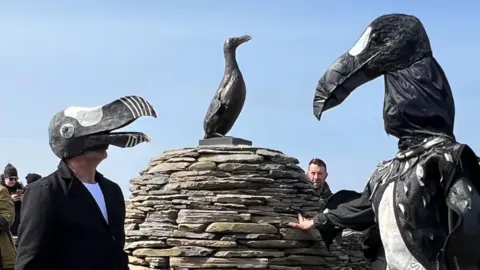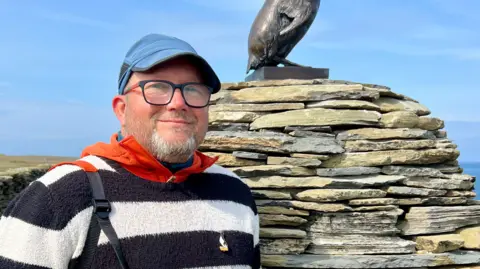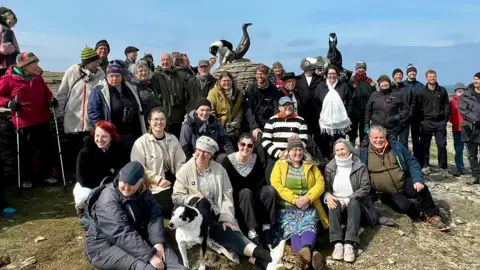Bronze statue is exact replica of Orkney's last Great Auk
 BBC
BBCA bronze statue has been unveiled as a memorial to the last Great Auk killed on the Orkney island of Papa Westray.
It is an exact copy of the last of the giant seabirds that lived on the island in 1813.
The original remains of the Papa Westray Great Auk have been preserved by the Natural History Museum in London. These were scanned and cast in bronze.
The flightless bird lived in large colonies on both sides of the Atlantic and was hunted to extinction by the 1850s.
 Rob Flett/BBC
Rob Flett/BBCThe statue was unveiled to the Papa Westray community after six years of fundraising, at a time seabird numbers on the island are in decline.
It is the newest attraction on the island - famous for having the world's shortest scheduled flight from its larger neighbour, Westray.
Island ranger Jonathan Ford first visited in pursuit of the Great Auk in 2005.
He now lives in Papa Westray and shows visitors its sights and its birds.
"I became obsessed with black and white birds," he said
"I saw the last breeding pair in the British Isles were killed here. So that brought me to the island otherwise I would never have visited."
He added: "If Orkney's North Isles Landscape Partnership had not existed we would not have received the funding. It's been a long process but it's been worth it."
 Rob Flett/BBC
Rob Flett/BBCFor the Natural History Museum's Joanne Cooper, seeing the statue for the first time was an emotional moment.
In her role as senior curator she looks after the original Papa Westray specimen.
"To see it so beautifully done with the texture so detailed in bronze was really staggering. It's just perfect," says Joanne.
Mystery surrounds how the Papa Westray bird was killed. It's believed to have been shot after a collector placed a bounty on its head.
The seabird could not fly, but it was an excellent swimmer.
Islanders recall stories of a six-hour chase by men in a boat, which ended with the exhausted bird being clubbed to death.
Now, it is part of one of the world's largest collections of Great Auk remains, which includes several eggs.
Honest interpretation
The specimen is too fragile to be put on public display and is rarely moved.
"This is a really honest interpretation of what our bird is like now," said Joanne.
"You can see the wear and tear of time and where patches are missing on the wings. It's authentic."
Papa Westray would usually be noisy with bird life at this time of year, but local ornithologists attending the unveiling remarked how quiet it was.
Within living memory the island would be home to 15,000 breeding pairs of Arctic Terns.
Now just 200 pairs have been reported each season, with few chicks surviving long enough to leave.
The new statue stands on the island as a cautionary tale of man's tendency to exploit natural abundance beyond its limits, which remains relevant to this day.
